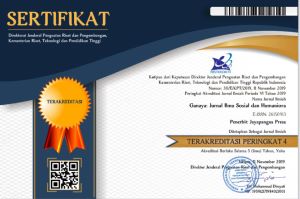Upacara Pemakaman Ngutang Mayit Kepercayaan Masyarakat Trunyan Bangli
DOI:
https://doi.org/10.37329/ganaya.v4i4.3093Keywords:
Ngutang Cemetery, Trust, Trunyan CommunityAbstract
The Hindu-Trunyan religious beliefs in Trunyan Village, Bali, differ from the Balinese Hindu religion in celebrating important ceremonies such as Galungan, Kuningan, Nyepi, Ciwaratri, Sarasawati, and Pagarwesi, which are generally carried out by Hindus in Bali. In contrast, Trunyan Hindus hold important ceremonies unique to themselves or may not even celebrate at all. The research method in this literature study is library research, which involves collecting data from various library sources such as books, encyclopedias, documents and scientific journals. The funeral ceremonies in Trunyan Village are divided into three locations, namely Sema Wayah, Sema Nguda, and Sema Bantas, which are differentiated based on the circumstances of a person's death, not based on their social status or position.References
Ang, S. H. (2014). Research Design for Business & Management, London: SAGE Publications. Conducting a Literature Review,
Efferin, S. (2015). Akuntansi, Spritualitas Dan Kearifan Lokal Beberapa Agenda Penelitian Kritis. Jurnal Akuntansi Multiparadigma 6(3), 466-478.
Enticott, J., Shawyer, F., Vasi, S., Buck, K., Cheng, I.-H., Russell, G., Kakuma, R., Minas, H., & Meadows, G. (2017). A Systematic Review of Studies With a Representative Sample of Refugees and Asylum Seekers Living in the Community for Participation in Mental Health Research. BMC Medical Research Methodology 17(37), 1-16.
Galešić, M., Olsson, H., Dalege, J., Does, T. van der, & Stein, D. (2020). Integrating Social and Cognitive Aspects of Belief Dynamics: Towards a Unifying Framework. Running Head: Belief Dynamic Framework, 1-37.
Gao, Y., & Ya-fang, Z. (2021). Exploring Language Teachers’ Beliefs About the Medium of Instruction and Actual Practices Using Complex Dynamic System Theory. Frontiers in Education 6, 1-12.
Mahardika, I. W. T., & Darmawan, C. (2016). Civic Culture Dalam Nilai-Nilai Budaya Dan Kearifan Lokal Masyarakat Bali Aga Desa Trunyan. Humanika, 23(1), 20.
Mrklas, K., MacDonald, S. E., Shea‐Budgell, M., Bedingfield, N., Ganshorn, H., Glaze, S., Bill, L., Healy, B., Healy, C., Guichon, J. R., Colquhoun, A., Bell, C., Richardson, R. E., Henderson, R., Kellner, J. D., Barnabé, C., Bednarczyk, R. A., Letendre, A., & Nelson, G. (2018). Barriers, Supports, and Effective Interventions for Uptake of Human Papillomavirus- And Other Vaccines Within Global and Canadian Indigenous Peoples: A Systematic Review Protocol. Systematic Reviews 7(40), 1-20.
Ngara, C. (2010). Creative Vision and Inspiration of Shona Stone Sculptors. Psychology of Aesthetics Creativity and the Arts 4(3), 181-192.
Rodriguez, N., Bollen, J., & Ahn, Y. (2016). Collective Dynamics of Belief Evolution Under Cognitive Coherence and Social Conformity. Plos One 11(11), 1-15
Yandani, N. M. M., & Suryanata, I. G. N. P. (2019). Pengaruh Penerapan Prinsip-Prinsip Good Corporate Governance Dan Budaya Tri Hita Karana Terhadap Kinerja Manajerial Lembaga Perkreditan Desa (Lpd) Pakraman Padangsambian. Jurnal Ilmiah Akuntansi Dan Bisnis 4(1), 24-37.
Yasa, I. W. P. (2020). Tri Hita Karana Untuk Pencegahan COVID-19 Di Bali. Jurnal Socius Journal of Sociology Research and Education 7(1), 54-66.
Yudantini, N. M. (2020). Bali Aga Villages in Kintamani, Inventory of Tangible and Intangible Aspects 192, 160-165.
Yudantini, N. M., & Kastawan, I. W. (2018). Lansekap Budaya: Makna dan Peranan Pemakaman Hindu Bali pada Desa-desa Tradisional Bali Aga. Prosiding Seminar Arsitektur Nusantara IPLBI, 1-8.
Downloads
Published
How to Cite
Issue
Section
License
Copyright (c) 2021 Ni Wayan Yuli Juniari, Anak Agung Ayu Alit Widyawati (Author)

This work is licensed under a Creative Commons Attribution-ShareAlike 4.0 International License.
An author who publishes in the Ganaya : Jurnal Ilmu Sosial dan Humaniora agrees to the following terms:
- Author retains the copyright and grants the journal the right of first publication of the work simultaneously licensed under the Creative Commons Attribution-ShareAlike 4.0 License that allows others to share the work with an acknowledgement of the work's authorship and initial publication in this journal
- Author is able to enter into separate, additional contractual arrangements for the non-exclusive distribution of the journal's published version of the work (e.g., post it to an institutional repository or publish it in a book) with the acknowledgement of its initial publication in this journal.
- Author is permitted and encouraged to post his/her work online (e.g., in institutional repositories or on their website) prior to and during the submission process, as it can lead to productive exchanges, as well as earlier and greater citation of the published work (See The Effect of Open Access).
Read more about the Creative Commons Attribution-ShareAlike 4.0 Licence here: https://creativecommons.org/licenses/by-sa/4.0/.








